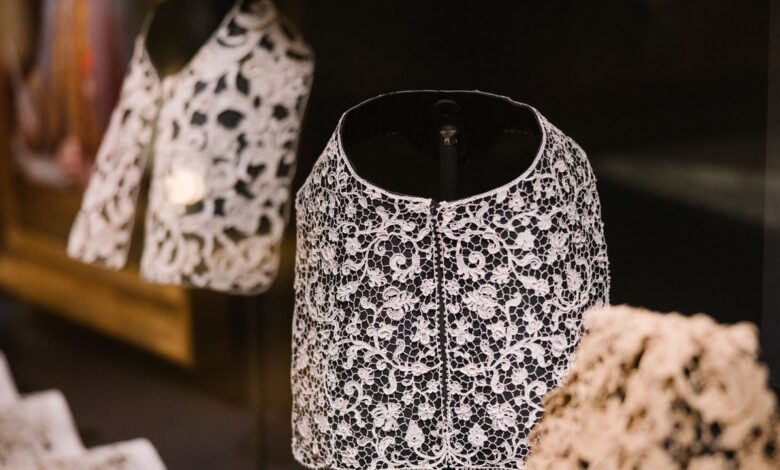In New York, an Exquisite Examination of the History—And Future—of Lace

For “Threads of Power,” Kanagy-Loux created a bobbin lace collar in red silk, inspired by iconography that appears in another work on display: a 17th-century Italian lace border depicting the Hebrew Bible story of Judith beheading the Assyrian general Holofernes, who was besieging her city. Judith has long been celebrated as a feminist icon, and the beheading of Holofernes—portrayed with gory tabloid splendor by Italian Baroque painter Artemisia Gentileschi—an assertion of female power worthy of our #MeToo moment. Kanagy-Loux’s blood-red collar hints at the violence that lies behind many of the delicate examples of unearthly feminine dexterity on view here.
Did eyes go blind, for example, working by a window’s filtered daylight or by candlelight, to create the stunning 18th-century needle-lace chalice cover whose silk and gold threads trace a swirling symphony of flowers and leaves? Upstairs, in a section on ecclesiastical lace, a chasuble consisting of sculptural white linen point de Venise lace layered over pink silk was destined to be worn exclusively by a priest officiating at Mass on the fourth Sunday of Lent. Did the nuns who spent perhaps hundreds of hours fashioning its florid volutes ever dream of other worlds? What toll was exacted by the patience and fortitude required of skilled and highly trained women, working without the protection of a guild, to sit by the hearth, their foot perhaps rocking a cradle, and labor for years at the creation of adornments that would never be theirs to own?
Eyes blurring and head spinning, it was something of a relief to arrive (on the exhibition’s third floor) at the late 19th century and the invention of industrially produced “chemical lace.” The city of St. Gallen played a leading role in the development of this technique, in which machine embroidery on a silk ground was dipped in chemicals that dissolved the ground, leaving the embroidered threads behind to form a convincing imitation of handmade lace. (Today more environmentally friendly methods of production predominate.)
It was exciting to catch a glimpse, in the exhibition’s final room and amid the lacy creations of postwar couturiers—Dior, Givenchy, Yves Saint Laurent, et al.—of the future of lace. St. Gallen manufacturer Jakob Schlaepfer’s computer-generated Hypertube lace, for example (globs of silicone arranged in archival lace patterns) has been used by Yang Li, Comme des Garçons, Iris van Herpen, and others.
Get Best News and Web Services here







